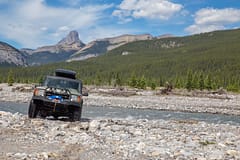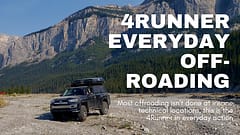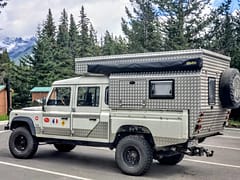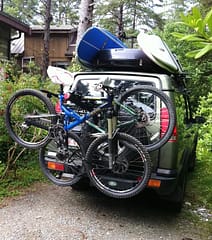Overland Techniques for Rough and Rocky Tracks
As Slow as Possible and as Fast as Necessary
Contents
Introduction
Rough and rocky tracks come in all shape and form. They can be up in the mountains, in amongst the forests and even in the desert. Yes, I did say desert, not all deserts are just sand.
When you are faced with driving such features, you need first to think back to the very basics of 4wd and check out the previous articles on Hazard Identification, Vehicle Geometric Limitations, Ascents and Descents as well as the one on ABS,TC and HDC Controls. If you don’t take these and the various driving techniques into consideration you are likely to be inviting trouble or failure.
Hang Ups & Dangly Bits
That’s right, Hang Ups and Dangly Bits to be discussed first…
This content was developed by and owned by Paul Sinkinson, Xplorability owner. Paul is a 4wd Defensive Driver Training Consultant/Trainer and Programme Developer.
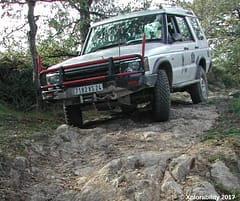
Let’s start underneath at the front. The lowest vulnerable parts here are the Front Differential and the Suspension linkages followed up by the Steering Arms. Of course there are also the Gearbox and the Transfer Case to consider. Damage to ANY of these will cause you problems, especially those with oil in them.
Check under your vehicle and find out where things are – you can see here the Shock Absorber Struts are lower than the Differential although to some extent the wheels offer them some protection
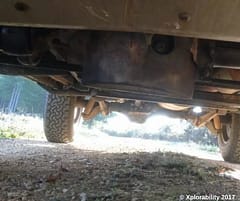
So, what can you do to protect them? Well, the obvious answer is under body metal guards where practical but they too can cause issues if you get hung up on them on rocks, tree stumps or bellied out in mud or sand so take that into account when fitting them and when using the vehicle in such conditions.
The “Lowest” point is going to be the Front Differential so you need to get down on your hands and knees and check exactly where that is in relation to the position of the driving position and the centre of the vehicle. That will allow you to choose your route over obstacles so you can avoid hitting it on them and cracking the casing. Differentials don’t run well without oil.
Ok, you’ve had a look under the front end, now it’s time to check out what’s below the blunt end, the rear. Here, we have another Differential on the Rear Axle. That too hangs down and is likely to be the lowest point although sometimes the various Suspension elements could be slightly lower at the extremities of the Axle. The other vulnerable item is the fuel tank. Just like the front, you can attach suitable protection guards to all these items.
The low points at the rear are the Rear Differential, Suspension parts and the Fuel Tank
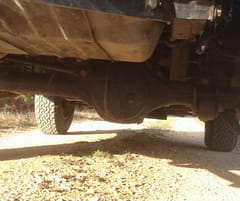
If the vehicle has a rear tow bracket or recovery point then this could be the lowest point and something that is likely to catch on rocks or terrain and extremely steep ascents.
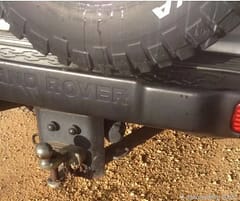
Be aware of ALL the vehicles Geometric Limitations
Rather than going over old ground again, this is the point to go back and read the previous articles on Ascents & Descents and also the one on the use of Traction Control (TC) and Hill Descent Control (HDC) as they are a good guide for ALL terrain including the Rough and Rocky Tracks. Remember the old phrase:
“As SLOW as POSSIBLE and as FAST as NECESSARY.”
SLOW is GOOD but there are times when you may need some speed to gain momentum but don’t go crazy. It is very easy to be swayed into idiotic attempts at such as rocky climbs or descents when surrounded by testosterone fueled friends. THINK SAFETY! Think Damage! Think Wallet!
On rough and rocky tracks you will find ruts of all shapes and sizes, they will be rock hard when dry and like driving on a yoghourt when wet and muddy.
When dry, if you are in the deeper ruts and don’t concentrate on your steering you may be overloading the system. Do that often enough and you will finish up with a leaky steering box, damaged steering pump, etc. When wet, be aware in the ruts of where your front wheels are as it is very easy to have the steering wheel set at 180 – 360 degrees out and the wheels may be on full lock without you realising it. IF the tyres suddenly gain traction, regardless of your speed the front of the vehicle may suddenly lurch in the direction the wheels are pointing. Exiting into trees or off the track at speed tends to come as a shock when this happens and you are likely to cause damage. Tree roots can also cause you traction problems in amongst rocks whether wet or dry. Be Aware!
Axle articulation with “Beam” axle’d vehicles helps with the undulating rocky terrain as the wheels are more likely to maintain traction_
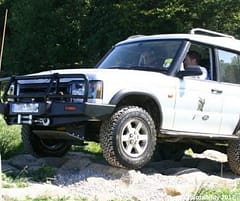
With all around “Independent” suspension, as the name suggests, each wheel can move up and down on the suspension wishbones independently of each other. On some rocky terrain, this can be an issue as if both front wheels (or both rear wheels) go UP over opposed rocks, it is possible that the low parts in between get nearer to the ground and they may make contact with obstructions so be aware of that when planning your route through obstacles. Some vehicles like this Discovery 3 have air suspension and can assist by raising the vehicle body for clearance. Vehicles fitted with Independent Suspension are more likely to raise a wheel off the terrain when crossing undulating terrain and may lose traction. Traction Control will help if this occurs.
Rocky obstacles
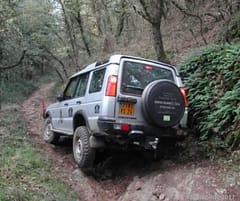
Even vehicles with Beam Axles such as the Discovery 2, when the suspension reaches its limit of travel the wheel will lift off the terrain and traction may be lost. This is the reason why it is always best to have the Centre Differential Lock (CDL) engaged so that only the opposing wheel on that axle is compromised and the other axle will continue to drive through the obstacle. If no CDL then TC should overcome the loss of traction. You can look up the previous articles on Traction Control in the Training Sections, which explain how to benefit from the system on ascents and descents with and without the use of the CDL. Remember, “Speed” creates “Bounce” which will in turn create a loss of traction over rough and rocky terrain. Always try and maintain this technique when Off-Road: “As Slow as Possible – As Fast as Necessary”
Rocky Desert
At the beginning of this article I mentioned that Deserts were not all sand. Even in the Sahara, much of it is like the photograph above so all the same information applies for dealing with rocky terrain although you may wish also to check out the article that will follows which covers driving in sand.
Vehicle driving in mixed rock, sand and gravel in the deep Sahara Desert in Southern Algeria.
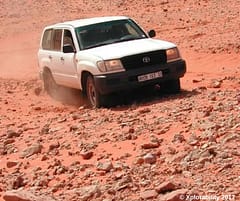
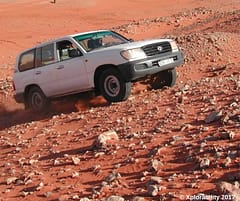
Actually, the photos above also highlights the fact that some rocks can be sharp and they can and will do damage to the vehicle’s tyres, especially if you may have reduced the tyre pressures to deal with the varied terrain. Be aware of that when choosing your route through obstacles. Don’t just look a yard or two in front, SCAN well ahead.
Steep Rock Face
From time you will come across Steep Rocky Ascents and Descents. These can be difficult even when dry, but in wet or damp conditions they can be extremely dangerous and slippery. The term “Greased Lightening” springs to mind. You can on the longer descents benefit from using the Hill Descent Control (HDC) as this works independently on each wheel however, on short steep descents you are likely to finish up impaled into the terrain at the base before the HDC wakes up to the fact it may be needed. So, be aware of this and make sure you get out and check and plan the best the route.
Steep rock face descent
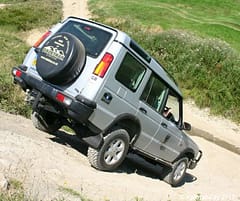
Ascents can also be tricky when it’s wet. Wet rocks and tree roots can cause the vehicle to slide sideways and with that loss of traction the driver can lose a sense of steering direction finishing up with the wheels pointing to one side when they think they are driving in a straight line.
If that happens and then with the wheels set to one side the tyres regain traction, the vehicle will suddenly lurch to that direction and could finish up sideways to the slope. Resultant weight transfer could in some cases lead to a rollover. An article on both On and Off- Road Rollovers in this Training Area will be available shortly. It’s a good idea to add a piece of white tape on the top centre position of the steering wheel rim as an indicator of where the wheel is, but do remember and be aware that it could be 360 degrees out.
Navigating Rocks Summary
- Carry out Hazard ID and Safety Margin checks
- Beware of obstacles sticking out of banks and in rutted wheel tracks
- Engage low ratio 4wd, CDL and HDC for maximum control and traction as conditions deteriorate
- Choose a suitable gear and stay in it through all obstacles
- Appreciate vehicle to ground clearances and geometric limits
- After crossing rocky terrain, check tyres and tyre rims for damage, especially if low pressures are used
- Don’t forget to re-inflate your tyres afterwards
- Ensure that you disengage the Centre Differential Lock before you return onto Tarmac/Black Top/Hard Roads
Previous Article: How to Cross a Ditch
Next Article: 4x4 a Water Crossing
Check out other work by Paul, fiction thriller novels here.
Copyright
This content was prepared for the Off-Road Discovery Website by Xplorability 4wd Training
The Content - All Photographs and Photographic Copyright and All other Rights other Reserved October 2017. S.W. France. This content may not be copied or reproduced without the written consent of Paul Sinkinson – Xplorability Training.
For Use Only in 4wd and Light Vehicle Driver Training.
Not for Re-Publication, Distribution or use outside the Xplorability Training Programme
